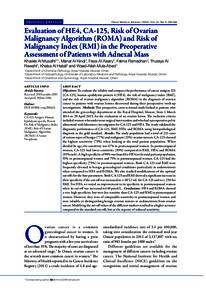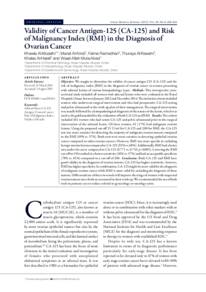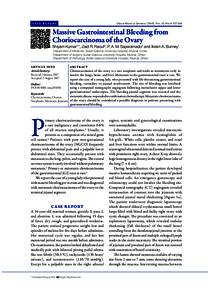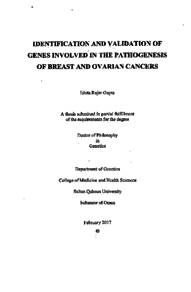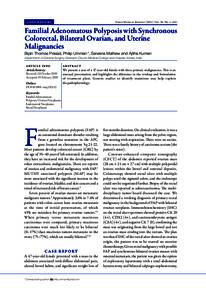Document
Evaluation of HE4, CA-125, risk of ovarian malignancy algorithm (ROMA) and risk of malignancy index (RMI) in the preoperative assessment of patients with adnexal mass.
Identifier
DOI 10.5001/omj.2016.68
Contributors
Al-Kindiyah, Manal., Author
Al-Aisaryiah, Faiza., Author
Ramadhan, Fatma., Author
Al-Rawahiyah, Thuraya., Author
Publisher
Oman Medical Specialty Board.
Gregorian
2016-09
Language
English
Subject
English abstract
Objectives: To evaluate the validity and compare the performance of cancer antigen-125
(CA-125), human epididymis protein 4 (HE4), the risk of malignancy index (RMI),
and the risk of ovarian malignancy algorithm (ROMA) in the diagnosis of ovarian
cancer in patients with ovarian lesions discovered during their preoperative work-up
investigations. Methods: This prospective, cross-sectional study looked at patients who
attended the gynecology department at the Royal Hospital, Muscat, from 1 March
2014 to 30 April 2015, for the evaluation of an ovarian lesion. The inclusion criteria
included women who underwent surgical intervention and who had a preoperative pelvic
ultrasound with laboratory investigation for CA-125 and HE4. The study validated the
diagnostic performance of CA-125, RMI, HE4, and ROMA using histopathological
diagnosis as the gold standard. Results: The study population had a total of 213 cases
of various types of benign (77%) and malignant (23%) ovarian tumors. CA-125 showed
the highest sensitivity (79%) when looking at the total patient population. When
divided by age, the sensitivity was 67% in premenopausal women. In postmenopausal
women, CA-125 had lower sensitivity (89%) compared to RMI, HE4, and ROMA
(93% each). A high specificity of 90% was found for HE4 in the total patient population,
93% in premenopausal women and 75% in postmenopausal women. CA-125 had the
highest specificity (79%) in postmenopausal women. Both CA-125 and RMI were
frequently elevated in benign gynecological conditions particularly in endometriosis
when compared to HE4 and ROMA. We also studied modifications of the optimal
cut-offs for the four parameters. Both CA-125 and RMI showed a significant increase in
their specificity if the cut-off was increased to ≥ 60 U/mL for CA-125 and to ≥ 250 for
RMI. For HE4, we noted an improvement in its specificity in postmenopausal women
when its cut-off was increased to140 pmol/L. Conclusions: HE4 and ROMA showed
a very high specificity, but were less sensitive than CA-125 and RMI in premenopausal
women. However, they were of comparable sensitivity in postmenopausal women and
were valuable in distinguishing benign ovarian tumors or endometriosis from ovarian
cancer. Modifying the cut-off values of the different markers resulted in a higher accuracy
compared to the standard cut-offs, but at the expense of reduced sensitivity
Member of
Resource URL
Citation
Al-Musalhiyah, Khawla, Al-Kindiyah, Manal, Al-Aisaryiah, Faiza, Ramadhan, Fatma, Al-Rawahiyah, Thuraya, Al-Hataliyah, Khalsa, & Mula-Abed, Waad-Allah S. (2016).Evaluation of HE4, CA-125, risk of ovarian malignancy algorithm (ROMA) and risk of malignancy i
Category
Journal articles

